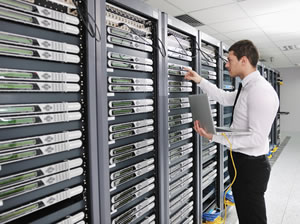
There hasn’t been much opposition to ridding college campuses of clunky, energy-guzzling server racks, campus technology chiefs say, although creating virtual servers could result in an unwieldy mess if ed-tech staff aren’t careful.
Colleges and universities, like much of the private sector, have gravitated toward virtual servers in recent years—a move that lets campus technology officials clear the piles of servers that collect over time, cut down on electricity use, and satisfy faculty requests for more servers in less time.
The largest research universities and small private colleges alike have gone virtual with their campus’s servers, meaning the machinery is managed in a distant data center, for example.
In fact, server virtualization was the most common strategy for improving colleges’ energy efficiency, according to CDW-Government’s 2010 Energy Efficient IT Report, a survey that tracks the latest in money-saving campus technology strategies. Sixty-three percent of higher-education respondents said they had moved to virtual servers to save on electricity bills, according to the report.
More stories about server virtualization in higher education…
Campus technology departments going green
The list of pros for server virtualization is lengthy, campus technology officials say, but virtualization “sprawl”—creating an army of virtual servers—remains a con that colleges should be wary of.
“It’s easy to say, ‘Throw another server up for me,’” said Jonathan Domen, an IT network analyst at Bryant University in Smithfield, R.I., where ed-tech decision makers transitioned to virtual servers with the help of network solutions company Bradford Networks. “As great as [server virtualization] is, it’s also a potential negative because it’s so easy to do it. … It can get unmanageable.”
Establishing strict provisions for when ed-tech staffers can add another virtual server to the school’s network, Domen said, is a key to avoiding a glut of servers. Implementing patches and security upgrades with so many virtual servers could waste staff time, he explained.
“You have to include solid policies up front,” he said. “Otherwise it could get a little out of control.”
Managing virtual servers allows campus technology staff to capture an invaluable “snapshot” of the school’s network before a major upgrade is started that could lead to data loss. Having that snapshot handy, Domen said, would help ed-tech officials avoid having to “rebuild the system if something goes wrong.”
If server virtualization is combined with policies that put the brakes on a server overload, the benefits of managing off-campus servers will be realized within weeks of the transition, ed-tech leaders say.
Dan Lichter, director of systems and network infrastructure at Saint Xavier University in Chicago, said that before server virtualization took hold at the school, faculty members who requested a new server would have to wait weeks—even a month, sometimes—before the IT department could order, receive, install, and update the equipment.
Now, Lichter said, filling faculty server requests takes a day or so.
More stories about server virtualization in higher education…
Campus technology departments going green
“It has really become a no-brainer, and user satisfaction [has gone] way up,” he said. “In fact, they’re already a little spoiled from that.”
There has always been an efficiency sweet spot for sever use. Using physical servers at about 70 percent of their capacity has been a longtime goal in campus technology departments, because the equipment uses the same amount of electricity whether it runs at 10 percent of capacity or 70 percent, Lichter said.
The server will require more energy when it’s required to breach the 70-percent mark, he said, but that is only required once a week for many servers—and often less frequently than that.
If a physical server gets heavy usage once a week, Lichter said, “it’s idle for six days, using electricity and wasting money, taking up physical space in the data center. It’s just sitting there, not doing the job it needs to do. It’s waiting to do the job. … And you could have that same problem with dozens of servers.”
Lichter said “your efficiency would shoot through the roof” if campus technology departments could maintain that 70-percent usage. But that goal has been largely unattainable for colleges and businesses alike.
Rick Leclerc, director of sales engineering and co-founder of Bradford Networks, has worked with Bryant University since 2005 and said going virtual with server racks fits with schools’ growing “green” initiatives aimed at curbing emissions and trimming energy costs as university budgets stagnate in the struggling economy.
“The movement is under way to limit the hardware footprint,” Leclerc said. “It’s definitely on the green initiative side. … Reducing the amount of heat output means less cooling, so the fewer servers, the less cost.”
Bryant University, included in the Princeton Review’s first Guide to Green Colleges last year, saved 15 percent in energy costs for its data center operation, according to university statistics.
Removing physical servers from campus reduced the IT floor space requirement by about half in 2010, and ed-tech officials reported a 30-percent time saving and 15-percent increase in service delivery.
More stories about server virtualization in higher education…
Campus technology departments going green
“For many IT organizations, the savings from server virtualization would have represented the conclusion of a very successful IT initiative. However, for Bryant University it was just the beginning,” said Art Gloster, the university’s vice president and CIO. “We have opportunities to enter a new stage of IT maturity by leveraging virtualization across multiple facets of IT infrastructure, thus delivering maximum value with minimal cost consequences.”
Aris Ventura, an inside storage solution architect for CDW-G, said that even as physical servers pile up on college campuses, IT pros will see many of their servers working at about 3 percent capacity. Virtual servers can use more than 60 percent of their capacity, Ventura said.
“Essentially, if a customer buys a server specific application, they end up purchasing hardware that is never fully used to its potential,” he said. “This practice results in wasted energy and hardware costs.”
Virtualization, of course, isn’t limited to server racks. Colleges also have slashed energy costs by virtualizing the hundreds of computers spread throughout campus.
Karl Herleman, CIO at Miami Dade College, has, like many campus technology decision makers, moved his eight-campus school toward virtualization in the past three years. This means one computer in a campus computer lab can power several machines.
Miami Dade College has trimmed its energy consumption by 10 percent since 2008, thanks largely to virtualization, Herleman said.
And while virtualizing computers and trimming budgets will bring a smile to the faces of deans and provosts, Herleman said, creating too many virtualized machines on a college campus can create a “sprawl” effect that makes it difficult for the college’s IT team to manage the growing number of computers, he agreed.
Herleman said sprawl is sometimes unavoidable. Some programs don’t operate easily on the same machine, forcing campus technology departments to approve another virtualized machine to keep programs away from each other on the same hard drive.
“You look at [virtualizing computers] and think, ‘Wow, it’s so easy to create these virtual machines and eliminate the need to buy a bunch of hardware,’” Herleman said. “Then you realize you have to deal with a whole new set of problems that come along with that. It can sometimes be worse than it was before you [virtualized machines].”
More stories about server virtualization in higher education…
Campus technology departments going green
- Research: Social media has negative impact on academic performance - April 2, 2020
- Number 1: Social media has negative impact on academic performance - December 31, 2014
- 6 reasons campus networks must change - September 30, 2014
